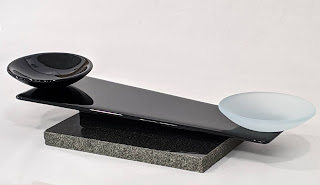Hacker's Guide to Art Glass Photography
 |
| Coneflower art glass vase (Dana Worley) |
I often hear glass artists say that they don't have good photos of their art because they don't have the right camera, don't have a photo booth setup, or simply don't have the time. Well, we're glass artists, right? We're creatives! We're spending our time and hard-earned money on supplies, equipment, and creating! That doesn't mean, however, that we can't get a little creative when it comes to photographing our work.
A few years ago I purchased a popup photo booth to use with my digital SLR camera. I bought two standing lamps so I would have adequate light. Unfortunately, the booth takes time to set up, and I still haven't made the time to learn how to use a digital SLR in something other than auto mode. Photographing my art was a chore and I was not getting photographs of most of my creations.
It occurred to me that I was over-thinking things. I didn't need a photo booth and high-end camera. The critical things I needed were a clean background, good lighting, and a camera -- any camera (I've heard it said that the best camera is the one you have with you). Following is a quick and inexpensive Hacker's setup for art glass photography.
- Camera: I've found that cell phone cameras do a good job of adjusting for white balance, and most phones these days come with software that will let you make quick adjustments to lighting and contrast (many have preset filters you can choose from). Also, the resolution of cell phone cameras is more than adequate for most of our uses.
- Lighting: When it comes to lighting, it's helpful if all of your lighting has the same color temperature. Color temperature!? The short version of that is if you want to photograph in sunlight, use only sunlight. Same goes for LED or other bulbs. If you want to use a 5K LED, use only 5K LEDs. Try not to mix light sources and you'll have better outcomes.
- Background: A piece of foam core board and a white or grey drape provide a nice platform with a background that will make sure your art is the center of attention. For the drape in the photos below, I've used one of the backgrounds that came with my photo booth, but any white or grey cloth -- or even a roll of white paper -- will work (just be careful of shiny or textured surfaces, which will cause reflection or odd patterns to show up in the photos).
So here's the Hacker's setup I use in my studio:
I now have no excuse for not taking photographs of my work. I hope you'll be able to use this information or come up with your own hack so you are getting great photos of your work!
Happy fusing, Dana
More Resources
Bullseye Glass Video, "Photographing Glass" https://videos.bullseyeglass.com/videos/photographing-glass/?a_aid=53ae25e2983c3
Learn fused glass on-line! Bullseye offers a variety of educational videos. Click banner below:






